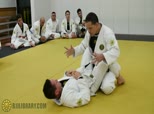Inside the University 444 - Collar Drag Set Up from Closed Guard
Add to Favorites Remove From Favorites 832 2497 days ago
From the closed guard, Saulo first makes a deep cross collar grip, and his other hand grips the same side sleeve. He plants his feet on the mat and turns to his side, just with his knee shield across the belly, same as before. From here, he can place his feet on the hips and scoot his way to classic collar and sleeve guard. Now he has the option of pushing off the hips to raise his own hips, and drag the collar to the side as he escapes to the opposite side, putting himself in position to attack his opponent's back.
Inside the University 443 - Maximizing Results During Practice
Add to Favorites 661 Remove From Favorites 2499 days ago
Having his white belt students demonstrate the position, Saulo corrects some mistakes, and also stresses the importance of communicating with your training partners to maximize your practice. Again covering the key points of the movements, Saulo stresses to drill using proper technique rather than strength and speed. Students must work together to learn more efficiently.Inside the University 442 - Defending Punches from the Closed Guard
Add to Favorites 746 Remove From Favorites 2500 days ago
In this scenario, an attacker has gotten you to the ground and is inside your guard throwing punches. The first step is to plant both feet on the ground and turn to your side, using your knees as a shield to keep the distance between your attacker. Next plant your hand on the ground and grab the back of his head with your other hand, pulling it down as you raise your hips off the ground. Now using momentum, you can push off your opponent and stand up into base, but stay low and keep heavy pressure on him with your shoulder to limit his mobility.Inside the University 441 - Words of Inspiration from Saulo
Add to Favorites 667 Remove From Favorites 2500 days ago
Saulo begins class with a motivating speech focusing on ways to learn, progress, achieve and be happy both on and off the mats.Inside the University 440 - Xande Sparring
Add to Favorites 778 Remove From Favorites 2502 days ago
Here is Xande sparring at the University in preparation for competition.Inside the University 439 - Hugo Marques Takedown Sparring
Add to Favorites 602 Remove From Favorites 2503 days ago
After a tough training in preparation for competition, Hugo Marques stays in the middle while fresh opponents come in every minute to battle for takedowns.Inside the University 438 - Getting Full Rotation
Add to Favorites 613 Remove From Favorites 2504 days ago
Another detail while Gustavo turns his hips in the air is that he is rotating fully, until he is looking at the mat. From here, his opponent cannot continue to control his legs and will give up space for Gustavo to recover guard. Once he has recovered guard, Gustavo likes to immediately throw some attacks, like an omoplata, collar drag or anything available to keep his opponent defending.Inside the University 437 - Avoiding Pressure
Add to Favorites 736 Remove From Favorites 2506 days ago
Focusing on a common mistake he sees his students making, Gustavo shows how some are crunching their bodies up and actually creating more pressure on themselves. Instead, they should be basing on their elbow and extending their body away from their opponent. Then he has the leverage to straighten his arm and bring his hips high in the air and turn to recover his guard.Inside the University 436 - Finding Space Under the Head
Add to Favorites 699 Remove From Favorites 2507 days ago
Answering a student's question about what to do when your opponent buries his head in your chest and doesn't give the space to make a collar grip, Gustavo just pushes the shoulder to defend the pass, and eventually his opponent will move and open the space. It is important, however, that he doesn't push his opponent's head. This will only make passing the guard easier for him.Inside the University 435 - Defending the Leg Squeeze Pass
Add to Favorites 787 Remove From Favorites 2508 days ago
Professor Gustavo's opponent has both of his legs squeezed and is trying to pass his guard, so first Gustavo bases up on his elbow and reaches his other hand in for a cross collar grip and extends his arm. Pushing the edge of his foot off the floor, Gustavo raises his hips off the mat and turns facing down with his butt high in the air. As soon as he feels his opponent readjust his position, he turns back and replaces his guard.Inside the University 434 - Extending Your Body Away from Your Opponent
Add to Favorites 779 Remove From Favorites 2509 days ago
Correcting the most common mistake of his students, Saulo shows how he extends his body away from his opponent after he has connected his elbow and knee. Once his body is straight, then he can escape the hips and bring his inside leg back in to recover his guard. As always, he emphasize the need to drill over and over, repetition is the only way to learn.Inside the University 433 - Defending from Your Side
Add to Favorites 810 Remove From Favorites 2510 days ago
Answering some questions, Saulo stresses the importance of staying on your side after you bridge, and not letting your opponent flatten you out. Also, once your elbow and knee are connected, you must push off to extend your body, and then you will have the space to recover your guard.











